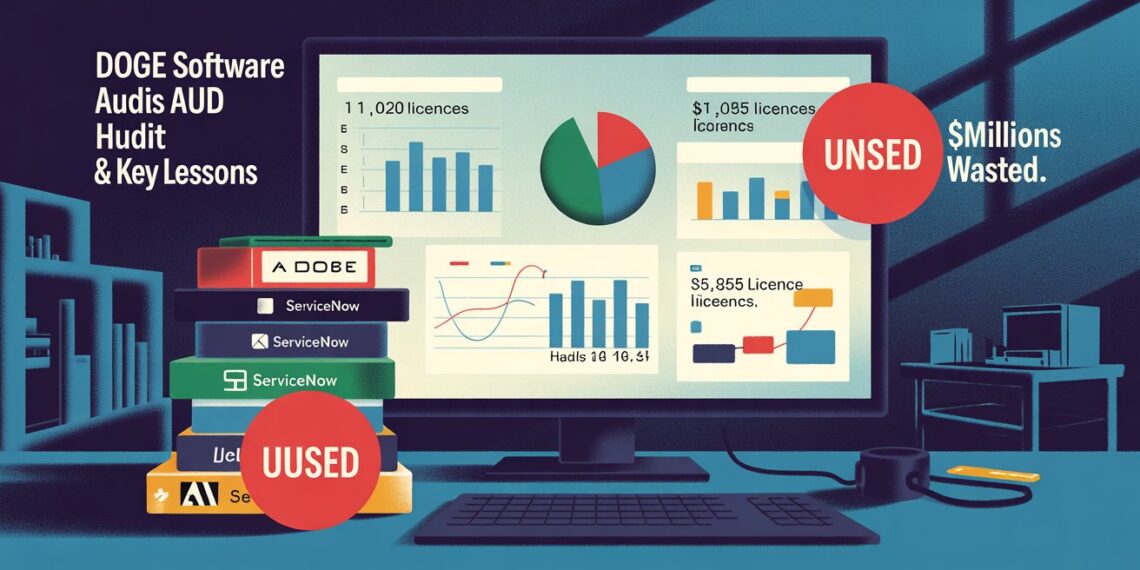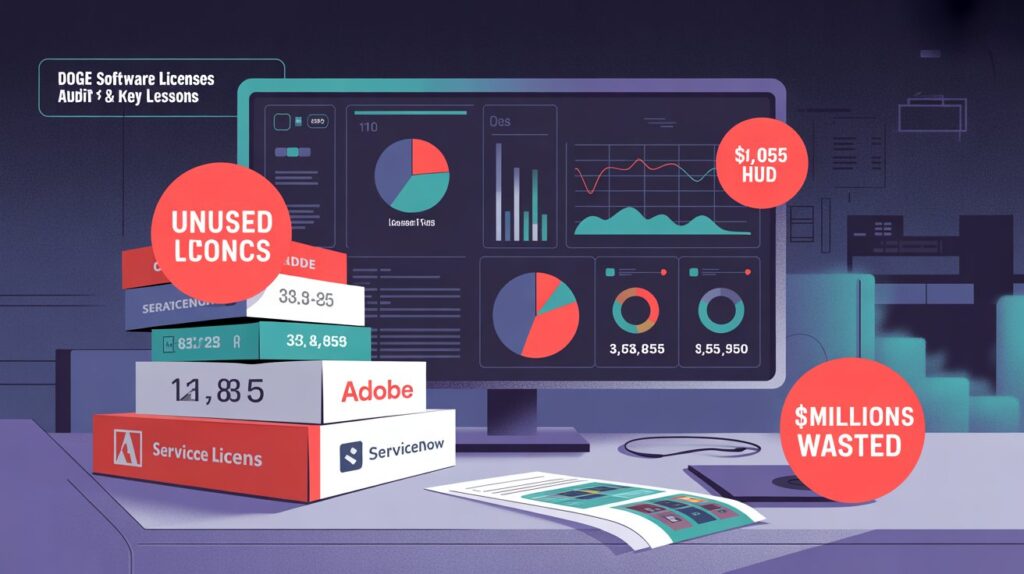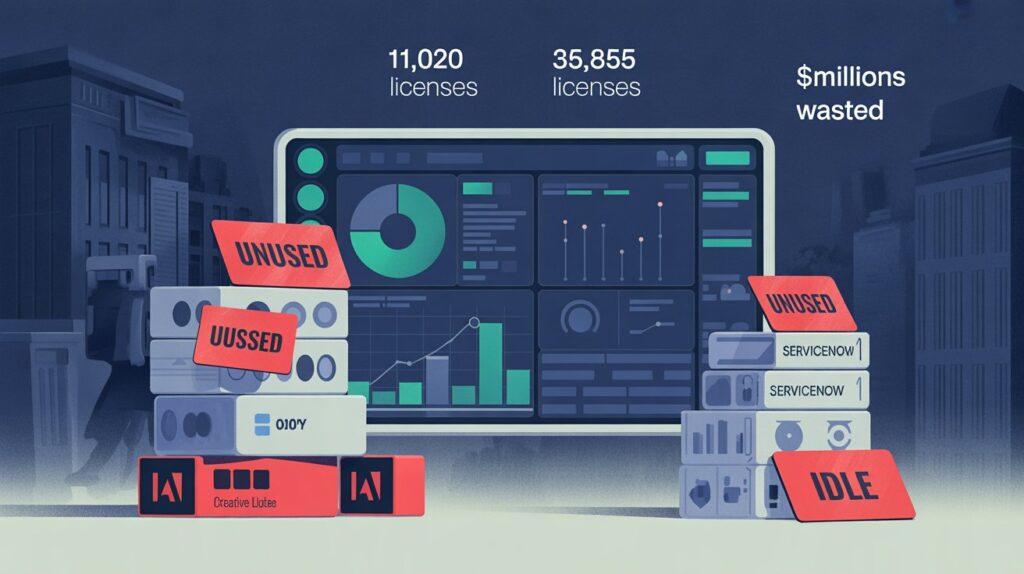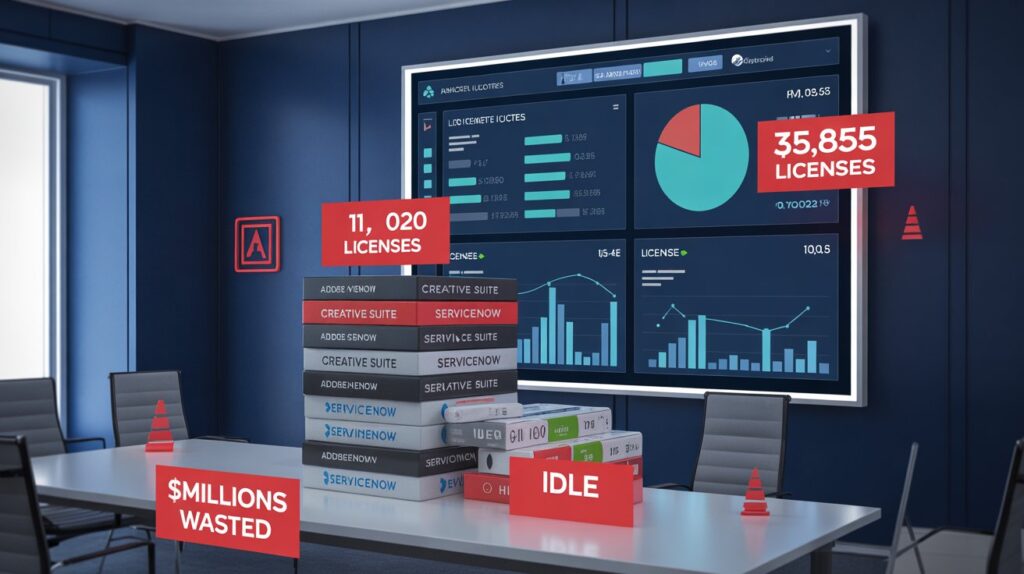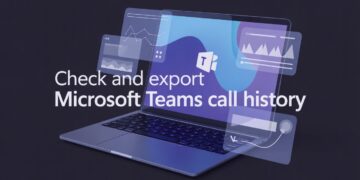When a routine software audit turns into a headline story, it usually means something bigger than accounting oversight is at play. That’s what happened with the Doge Software Licenses Audit at HUD (Department of Housing and Urban Development) — an investigation that revealed tens of thousands of paid software licenses sitting idle, unused by any employee, yet quietly draining government budgets.
The numbers were striking: 11,020 Adobe Acrobat licenses with zero users, and over 35,000 ServiceNow licenses attached to systems with only a few dozen active accounts. For many observers, this looked like an absurd example of government inefficiency. But for those familiar with large-scale software management, the story also highlighted a broader problem that plagues both public and private sectors — poor visibility into digital assets and a lack of centralized license governance.
In this comprehensive analysis, we’ll explore what the Doge Software Licenses Audit uncovered, why this kind of waste happens, and how both government agencies and enterprises can prevent it. You’ll also learn how to structure an effective internal audit, interpret usage data correctly, and build a real-time license compliance dashboard.
The Doge Audit: What Happened and Why It Matters
The Doge Software Licenses Audit HUD began as part of a broader government efficiency initiative, aiming to identify redundancies and misallocated spending across technology portfolios. What investigators found at HUD was a textbook case of software sprawl — where licenses are purchased in bulk without active tracking or alignment to actual needs.
Key Findings from the Audit
Software Product |
Licenses Paid For |
Active Users |
Estimated Idle Licenses |
Estimated Annual Cost Waste |
|---|---|---|---|---|
Adobe Acrobat Pro |
11,020 |
0 |
11,020 |
$3.8 million+ |
ServiceNow (Multiple Modules) |
35,855 |
84 |
35,771 |
$12–15 million |
Microsoft Visio |
6,000 |
600 |
5,400 |
$1.1 million |
Total (Sample Audit Scope) |
52,875 |
684 |
52,191 |
$17–20 million+ |
While the figures vary across sources, the message is consistent: HUD and several other agencies have paid millions of dollars annually for software licenses that remain inactive.
Why This Isn’t Just a HUD Problem
Although this story caught attention for its scale and absurdity, similar inefficiencies exist across countless organizations. Gartner estimates that up to 30% of software spending in large enterprises is wasted due to unused or underutilized licenses. In government agencies, the problem is amplified by long procurement cycles, legacy systems, and fragmented accountability.
What “Unused” Actually Means
Not every “unused license” represents pure waste. Some contracts require a minimum number of seats regardless of usage. Others are tied to devices, not individuals. The key takeaway is visibility — most agencies don’t have real-time data showing what is being used, by whom, and when renewals or true-ups are due.
Why Software Waste Happens: Understanding the Root Causes
Software waste rarely results from malice or neglect. It’s usually the byproduct of complex procurement processes, rapid digital expansion, and insufficient data integration. Understanding the root causes helps identify realistic fixes.
1. Over-Procurement and “Bulk Buy” Mentality
Government procurement often rewards volume discounts. Agencies buy thousands of licenses upfront to secure lower per-unit pricing, assuming future growth will justify the expense. Years later, those “extra” licenses quietly renew without scrutiny.
2. Decentralized IT Management
Different departments may buy their own tools independently. Without a unified asset inventory, duplicate purchases go unnoticed.
3. Legacy Contract Renewals
Contracts often auto-renew yearly. Without oversight, outdated tools remain on invoices long after they’ve been replaced or abandoned.
4. Misaligned Licensing Models
Modern software often uses mixed licensing — user-based, device-based, or concurrent use. Confusion about terms leads to inaccurate tracking.
5. Lack of Real-Time Usage Monitoring
Many agencies rely on static spreadsheets or periodic reports. Without automated usage telemetry, it’s impossible to identify idle accounts dynamically.
The Financial and Operational Impact of License Waste
The cost of unused software extends far beyond the price tag. It drains budgets, complicates compliance, and undermines digital transformation efforts.
Financial Consequences
-
Direct waste: Paying for inactive licenses adds up to millions annually.
-
Indirect waste: Oversized contracts increase support costs, maintenance fees, and renewals.
-
Lost opportunity: Money tied up in redundant licenses could fund modernization projects or cybersecurity upgrades.
Compliance and Security Risks
-
Idle accounts may still hold active credentials, creating unnecessary attack surfaces.
-
Unused software can fall out of compliance if version updates or security patches are neglected.
-
Vendors may impose penalties if usage tracking or audit documentation is inaccurate.
Strategic Impact
-
Budget inefficiency erodes public trust in government spending.
-
Leadership loses visibility into digital value.
-
Future planning becomes reactive rather than data-driven.
Inside the Audit Process: How the Findings Emerged
A thorough audit doesn’t start with accusations — it starts with data.
Step 1: Asset Inventory Collection
Auditors gathered all software contracts, procurement records, and license keys across HUD’s IT infrastructure.
Step 2: Usage Data Correlation
Each license was cross-referenced against user logs, system activity, and authentication data. This identified which seats were actually used.
Step 3: Reconciliation and Validation
Discrepancies between contract counts and real usage were flagged for investigation.
Step 4: Classification
Licenses were grouped into three categories:
-
Active and required
-
Inactive but reserved
-
Completely idle or redundant
Step 5: Reporting and Recommendations
A central dashboard — the so-called “Doge Software Licenses Audit HUD” — visualized compliance in real time.
How to Conduct an Internal Software License Audit
Organizations inspired by the Doge Audit can replicate the process with a structured framework.
Step-by-Step Framework
Step |
Action |
Purpose |
|---|---|---|
1 |
Collect all license contracts and purchase orders |
Establish scope |
2 |
Map licenses to departments or user groups |
Identify accountability |
3 |
Integrate usage logs from endpoints or SaaS tools |
Measure utilization |
4 |
Classify licenses as active, inactive, or redundant |
Create visibility |
5 |
Engage stakeholders for validation |
Prevent false positives |
6 |
Recommend rightsizing or reallocation |
Optimize cost |
7 |
Implement a dashboard for continuous tracking |
Sustain efficiency |
Key Metrics to Monitor
-
License utilization rate (%)
-
Average cost per active user
-
Renewal cycles and expiration alerts
-
License-to-employee ratio
-
Idle license duration
Building a “License Audit HUD”: Real-Time Compliance in Action
The concept of a HUD (Heads-Up Display) for license management isn’t science fiction — it’s best practice. A well-designed dashboard gives IT leaders visibility into usage, cost, and compliance at a glance.
Core Components of a License Audit HUD
-
Central Data Hub — Pulls real-time data from SaaS, on-prem, and cloud systems.
-
Usage Analytics Engine — Tracks login frequency, seat assignments, and activity logs.
-
Policy Compliance Layer — Flags breaches or misconfigurations.
-
Financial Module — Calculates cost per license and total waste.
-
Alert System — Notifies managers before renewals or contract expirations.
Benefits
-
Prevents surprise renewals.
-
Improves vendor negotiation power.
-
Enables compliance reporting.
-
Supports budgeting and forecasting.
Lessons from the Doge Audit for Government and Enterprise Leaders
1. Visibility Is Everything
Without accurate data, agencies can’t control costs. A single dashboard can reveal millions in potential savings.
2. Procurement Needs IT Collaboration
Purchasing decisions must involve both procurement and IT to ensure licensing models match real needs.
3. Audit Should Be Continuous, Not Periodic
Annual reviews are no longer sufficient. Automation enables continuous license monitoring.
4. Transparency Builds Public Trust
Publishing efficiency metrics demonstrates accountability and reinforces confidence in governance.
5. Reinvestment Creates Value
Funds recovered from redundant software can be redirected toward modernization, cybersecurity, or training initiatives.
How Private Sector Organizations Can Learn from HUD’s Mistake
Private companies face the same challenge — often worse. Complex vendor contracts, remote work expansion, and decentralized SaaS adoption make license tracking harder than ever.
Common Corporate Scenarios
-
Marketing teams purchasing duplicate design tools.
-
IT departments maintaining legacy on-prem software post-migration.
-
Contractors given licenses that remain active after offboarding.
Best Practices
-
Establish a Software Asset Management (SAM) function.
-
Integrate all procurement systems with a CMDB (Configuration Management Database).
-
Use role-based access control to align licenses with actual job functions.
-
Automate deprovisioning when employees leave.
A Framework for Sustainable License Governance
To maintain efficiency over time, agencies and companies should adopt a structured governance framework built on four pillars:
1. Policy
Define clear rules for license purchase, assignment, and renewal. Require pre-approval for new software acquisition.
2. Process
Document how license requests are reviewed, how usage is tracked, and how reallocation is managed.
3. People
Assign ownership — typically a Software Asset Manager or cross-functional committee.
4. Platform
Use an integrated technology solution (dashboard or SAM tool) that connects procurement, IT, and finance systems.
Technology Solutions for Real-Time License Management
Modern software asset management tools make it easier to monitor usage and compliance. While specific vendor names vary, look for these features:
Feature |
Description |
Why It Matters |
|---|---|---|
API Integrations |
Connects to SaaS and on-prem systems |
Enables holistic visibility |
Automated Usage Tracking |
Monitors logins and activity |
Eliminates manual audits |
Renewal Alerts |
Sends notifications before contract expiry |
Prevents auto-renewal waste |
Cost Allocation |
Maps spend to departments |
Improves accountability |
Policy Automation |
Applies usage thresholds and compliance rules |
Reduces human error |
Implementing such systems can cut software waste by 25–40% within the first year.
The Broader Policy Perspective
Beyond internal cost control, the Doge Software Licenses Audit HUD has reignited conversations about public IT governance and the responsible use of taxpayer funds.
Policy Implications
-
Governments may introduce standardized software asset management requirements across agencies.
-
Oversight committees could demand periodic license utilization reports.
-
Vendors may face new contract transparency rules.
The SAMOSA Act Example
Some legislative efforts (like the Software Asset Management and Oversight in Software Acquisition Act) encourage agencies to document software inventories and justify renewals — a model that could expand following the Doge audit revelations.
Frequently Asked Questions (FAQ)
1. What is the Doge Software Licenses Audit HUD?
It’s a government software audit initiative that revealed large numbers of unused software licenses at the Department of Housing and Urban Development, highlighting inefficiencies in license management.
2. Why were so many licenses unused?
Factors include bulk procurement, outdated renewals, and decentralized IT oversight that allowed contracts to renew automatically without usage verification.
3. Is this issue unique to HUD?
No. Most large organizations — public or private — face similar waste levels due to poor visibility and tracking.
4. How can organizations prevent software license waste?
Implement automated tracking tools, conduct quarterly audits, and align procurement decisions with real user demand.
5. What are the benefits of real-time license dashboards?
They provide continuous visibility into usage, prevent over-spending, and simplify compliance with vendor and government audit requirements.
6. What happens to unused licenses once discovered?
Organizations can reallocate them, negotiate contract adjustments, or terminate unnecessary agreements.
7. What is E-E-A-T and why does it matter here?
Experience, Expertise, Authoritativeness, and Trustworthiness are the pillars of credible content and governance — the same principles underpin effective license management and transparency.
Conclusion
The Doge Software Licenses Audit HUD serves as a powerful reminder that digital inefficiency is often invisible until data exposes it. Whether in government or private industry, unchecked software licensing can silently drain millions from budgets and erode trust in management.
The solution isn’t only in cutting costs — it’s in building sustainable visibility. With a strong governance framework, continuous monitoring, and transparent reporting, any organization can transform from reactive oversight to proactive efficiency.
The message is simple:
Know what you own. Track what you use. Eliminate what you don’t.
If your agency or enterprise hasn’t conducted a comprehensive license audit in the past year, now is the time. The sooner you illuminate hidden waste, the faster you can redirect those funds toward true innovation and value creation.


